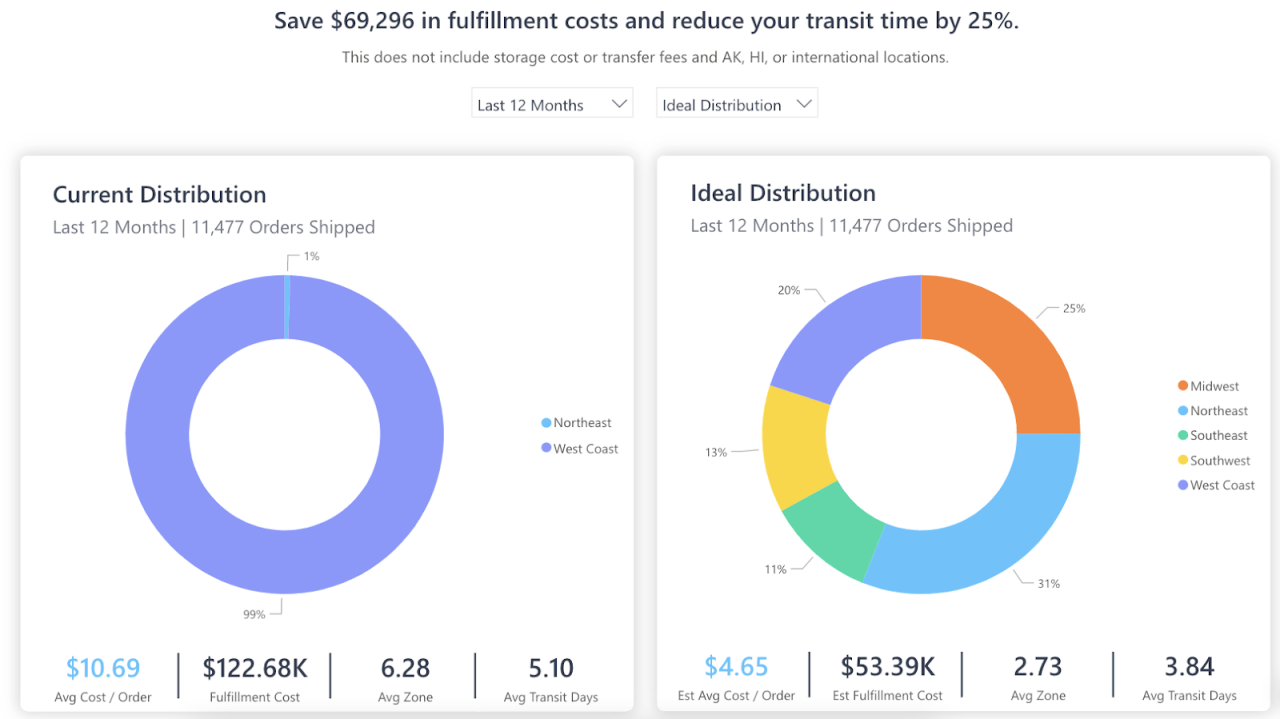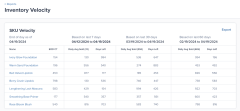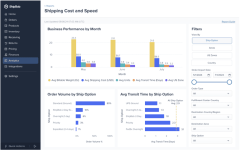Table of Contents
** Minutes
What is ecommerce as a service (EaaS)?
4 types of businesses that can leverage EaaS
When you’re building your ecommerce business, it can sometimes feel like you’re patchworking a solution together.
There are hundreds of different providers, partners, and tools out there, each of which specializes in one of the functions or capabilities your ecommerce brand needs. Many brands leverage a variety of these tools, and integrate them to form one solution.
However, some brands may want a single solution that can address every ecommerce need they have, from setting up their ecommerce website to shipping their orders. This type of solution is called “ecommerce as a service” (or EaaS), and can benefit brands that are looking to streamline their business’s operations.
In this guide, we’ll cover what the ecommerce as a service model is, what kinds of businesses can benefit from it, and how an expert supply chain partner like ShipBob can fill gaps in the EaaS model.
What is ecommerce as a service (EaaS)?
Ecommerce as a service (also called commerce as a service) is a type of all-in-one ecommerce solution where a third-party company provides every tool and service that a brand needs to build and manage its ecommerce operations.
ARROW: Ecommerce as a service (also called commerce as a service) is a type of all-in-one ecommerce solution where a third-party company provides every tool and service that a brand needs to build and manage its ecommerce operations.
This means that EaaS solutions will offer a host of capabilities under one roof, such as:
- Ecommerce platform hosting
- Marketing management (such as content management, search engine optimisation [or SEO], email marketing, and more)
- Checkout and payment gateways
- Analytics and performance data
- Warehousing and fulfilment services
- Last-mile delivery coordination
Managing all these functions and more through a single provider minimises the need for ecommerce brands to invest in separate services, which can save them time, hassle, and money.
What are the benefits of ecommerce as a service?
While the EaaS model might not be a good fit for every brand, there are some potential benefits to leveraging an EaaS solution.
Simplicity
When you opt for ecommerce as a service, you’re essentially outsourcing the majority of your ecommerce operations. This streamlines the process of managing various ecommerce functions, since you have a single partner and don’t have to juggle multiple providers and tools.
Scalability
Another great aspect of EaaS solutions is the flexibility to scale as you need. EaaS providers can adapt to the growing needs of your online business, which means you won’t have to invest in resources separately or change service providers to support your growth.
Cost-efficiency
One of the biggest appeals of EaaS is that it gives ecommerce brands the ability to tap into advanced ecommerce resources without making heavy investments themselves. Rather than building out their own infrastructure, technology, and team, ecommerce brands can tap into the existing resources that EaaS solutions offer to grow cost-effectively, save time, and remain agile. This also makes ecommerce expertise more accessible to businesses with smaller budgets, enabling growing brands to scale more easily.
Enhanced customer experiences
EaaS solutions allow businesses to deliver customer experiences that are on par with those delivered by ecommerce retail giants like Amazon. The tech-enabled services allow businesses to capture, process, and manage customer orders more efficiently and accurately. This contributes to faster, more seamless deliveries that enhance the customer experience, which will ultimately improve customer satisfaction.
4 types of businesses that can leverage EaaS
Some types of ecommerce brands are better suited to leverage the ecommerce as a service model than others. Here are 4 kinds of businesses that can benefit the most from an EaaS solution.

1. DTC brands
Most EaaS solutions are designed with direct-to-consumer (DTC) brands in mind, rather than B2B sellers. As a result, the services and solutions that ecommerce as a service providers offer are tailored to address the pain points of DTC merchants, including:
- Ecommerce platform management and integrability: Building your DTC ecommerce store on a hosting platform and integrating it with every other tool in your ecosystem can be a hassle. EaaS solutions simplify this process for DTC brands by offering their own ecommerce platforms that work seamlessly with their other in-house tools and capabilities.
- Payment processing and order confirmation: It’s a common fear for DTC brands that payments and orders will get lost in processing (especially when multiple technologies are involved) – but with ecommerce enablement under one roof through an EaaS solution, you’re at less risk for these issues.
- High shipping costs and slow shipping times: Since they may operate on a smaller scale than large ecommerce retailers, DTC brands usually don’t have the resources to cost-effectively provide fast shipping. EaaS solutions enable these brands to leverage best practices and economies of scale to lower costs while delivering faster.

2. Retailers expanding online
As retail stores expand their scope to include online retail channels (and even social media channels like TikTok Shop), it can be much harder to manage inventory and fulfilment for both their brick-and-mortar locations and online stores. Multichannel retailing requires enhanced inventory visibility that gives you an accurate understanding of how much inventory you have in stock, what you need to reorder, and when you need to replenish stock across all your locations.
EaaS solutions help to streamline this process with advanced technology that unifies all your inventory data in one place. You can use this to get real-time visibility into your inventory and optimise your retail distribution strategy accordingly. Even if you’re not looking to manage your inventory in-house, you can rely on their inclusive services to outsource your operations.

3. Ecommerce startups
When you’re just getting your ecommerce business off the ground, juggling multiple platforms, tools, and partners can be overwhelming – and expensive. It takes a lot of capital to invest in storage space for inventory, set up an ecommerce site, and pick, pack, and ship orders effectively, and handling all this yourself inhibits your brand from scaling quickly.
EaaS solutions give startups a single source of guidance, and streamline their tech stack enormously. They give new ecommerce brands access to essential ecommerce technology, operations, and support, and enable them to outsource a lot of their operations to free up time.

4. Subscription box services
Ecommerce brands that offer subscription services face a few unique challenges, including managing inventory levels and timing shipments correctly. As a result, these brands must find a reliable partner to support these requirements.
With the expertise and resources offered by ecommerce as a service providers, subscription box services can efficiently fulfil recurring orders to meet customer expectations. Some providers even offer customisation solutions like branded custom packaging that make for a delightful unboxing experience.
ShipBob: The ultimate supply chain partner
Many EaaS solutions on the market today focus primarily on customer acquisition – in other words, a lot of the services they offer (i.e., ecommerce platform hosting, marketing, checkout portals, etc.) are geared towards attracting and converting customers. While some EaaS providers also offer logistics services, logistics is an incredibly complex industry in and of itself that requires dedication and investment to master.
If your brand is particularly concerned about getting fulfilment and shipping right, it’s probably worth partnering with a supply chain expert like ShipBob. As a world-leading omnifulfillment platform, ShipBob has the expertise, network, and technology to handle and optimise your logistics operations for you, save you money, and help you scale your brand.
Here are just some of the ways that brands can leverage ShipBob’s solutions to grow their business while streamlining operations.
Order fulfilment services
With ShipBob’s outsourced fulfilment services, you can say goodbye to all the complexities of managing your own warehouse and fulfilling your own orders. Our technology-driven fulfilment services ensure that orders are efficiently fulfilled, with multiple checks and balances along the way to maintain accuracy.
We use proprietary algorithms to automate certain aspects of the fulfilment process to improve efficiency. For instance, picking lists are automatically generated based on optimal picking routes. This helps our picking staff to efficiently travel between shelves and aisles with minimal back and forth, so orders can get picked, packed, and shipped faster.
“ShipBob’s fulfilment is actually more accurate than our in-house fulfilment was! When we were picking and packing orders, around 2% of them would have some sort of quality control issue. ShipBob brought that error rate to essentially zero. We ship thousands of orders, and we’ve almost never had mispicks, incorrect quantities, or anything like that. We’re also saving money because we don’t have to pay to reship products or lose profit on returns, and it’s a better customer experience.” – Charlotte Katona, President of Makesy
Distributed inventory system
ShipBob’s fulfilment network includes dozens of fulfilment centres across the US, as well as facilities in the UK, Europe, Canada, and Australia. Leveraging this existing infrastructure, brands can store inventory in multiple fulfilment centres that are close to customer hubs, which reduces shipping time and costs. ShipBob even offers an Ideal Inventory Distribution tool that uses your brand’s real order data to calculate the most optimal split of inventory across our network that will enable you to meet demand most effectively.

ShipBob’s Inventory Placement Program further automates the physical aspect of inventory distribution. Through the program, you can send all their inbound inventory to a single hub location, and ShipBob’s team of experts will use inventory analytics to determine the most optimal distribution strategy and handle physically distributing your inventory regionally on your behalf.
“The ShipBob team told us about their Inventory Placement Program (IPP), which requires one shipment to a ShipBob Hub and they do the rest. We immediately thought, “That’s interesting, let’s try that,” since the way we were receiving didn’t make sense and this would save us so much time and money.
Once we got IPP up and running, it became clear that our old receiving processes were obsolete, and it didn’t make sense for us to have our own warehouse anymore. Using ShipBob’s fulfilment centre network and IPP made much more sense for us. The fact we’re able to add inventory and fulfilment centres in different regions using IPP to make sure customers get their orders fast has greatly improved our customer service and customer experience.”
Cesar Contreras, Head of Supply Chain of Wholesome Goods
Inventory management solutions
ShipBob’s dashboard features built-in inventory management capabilities that give you a comprehensive view of all your inventory across supply chain stages, sales channels, and geographies. With real-time inventory data at your fingertips, you’ll be able to see exactly how much of each SKU you have left in stock by location, enabling you to time replenishment correctly and avoid costly stockouts. You can even set up automatic reorder point notifications to get notified when a SKU’s count reaches a certain threshold.

“One of our main priorities was finding a reliable partner that could store all of our inventory and provide tools that would help us manage it. We rely heavily on ShipBob for inventory tracking and forecasting and that’s been a key part of our partnership. When thinking about fulfilment, there’s such a focus on the packing and shipping aspect that the inventory management piece can often go unnoticed. But ShipBob’s ability to help us track and reconcile inventory is really great.”
Callie Tivnan, E-commerce Manager, and Christina Williams, Customer Success Manager at Barefaced
2-day express shipping
Shipping is where DTC brands and ecommerce startups struggle the most to compete with leading ecommerce retailers. In a market where people who are online shopping enjoy the convenience of fast and affordable shipping, it’s become more challenging than ever to meet these expectations.
ShipBob’s 2-Day Express Shipping solution helps you stay competitive, providing 100% coverage for 2-day shipping across the contiguous United States, even from a single fulfilment centre. You can also add expedited shipping badges to product pages to attract your customers, helping you improve your conversion rates and drive sales.
Advanced analytics and reporting
ShipBob’s advanced analytics and reporting tool delivers key insights to inform your ecommerce decisions. You can keep track of metrics related to your inventory and fulfilment performance, warehouse operations, and shipping — all through a single dashboard.
With comprehensive supply chain analytics, you can understand how to make optimizations that improve your bottom line. Whether this involves how to plan your procurement, prepare for peak season order volumes, or optimise your shipping costs and times, these valuable insights will help you make data-backed decisions that benefit your business in the long run.


Case studies: Success with ShipBob’s solutions
These ShipBob offerings can lead to significant improvements in various aspects of your ecommerce operations. Take a look at how other businesses have benefited from ShipBob’s solutions.



Taste Salud
When Taste Salud was founded in 2021, founders Josh and Tyler were juggling multiple tasks — developing their product, designing their packaging, and marketing it – in addition to fulfilment. But when they sold 500 units just a few hours after launching, they realized they would need the help of an expert to continue scaling.
Within the first six months after partnering with ShipBob, Taste Salud was able to fulfil $350k worth of orders. They’ve since surpassed $20M in sales, and have no plans to slow down any time soon.
“We’ve scaled so much, and there have been zero hiccups in fulfilment with ShipBob. I don’t think even as we keep scaling in the years to come that there will be any hiccups there. That cannot always be said of brands that run their own warehouse. Running your own warehouse, you have to go out and hire very experienced people, invest in equipment, build in automation – and often, you’re wasting a lot of time, energy, resources, and human capital for a sub-par result. Why do that when a partner like ShipBob exists, and makes fulfilment so easy at a fair price?”
Tyler McCann, Co-Founder of Taste Salud



Our Place
As a brand that became a viral sensation, Our Place needed a fulfilment partner that could handle large-scale fulfilment while helping them streamline their workflows. ShipBob’s technology solutions and outsourced fulfilment services addressed these key needs, only requiring one individual to manage all the workflows in a single function.
Our Place now has the capability to receive and deliver orders within two and a half days on average, which is a significant reduction from the previous 5-6 days. ShipBob has also helped them to significantly reduce misshipments and improve order accuracy. Moreover, the brand has since been able to save $1.5 million in freight costs after leveraging the ShipBob fulfilment network.
“Being near our customers wasn’t just essential for delivering an exceptional customer experience; it also significantly boosted our revenue. Our Place’s products are readily gifted, which means that each day we can ship orders before a major holiday translates into over half a million dollars in revenue.
Pre-ShipBob, the last day customers could place orders and receive them by Christmas was around the 15th or 16th of December. Now, we can extend that to the 19th or 20th, confident that even with cost-effective ground shipping, we’ll deliver the items in time for the holiday. This extension allows us to capture an additional 4 or 5 days of revenue, totaling over two million dollars.”
Ali Shahid, COO of Our Place

Spikeball
ShipBob’s technology solutions are particularly useful for businesses that want to streamline their in-house fulfilment operations. Spikeball was initially relying a lot on tacit knowledge and outdated technology, which required months of experience. Moreover, their fulfilment operations consisted of 3-4 people who had to spend all day picking orders.
This changed when they implemented ShipBob’s warehouse management system to power their warehouse, which centralises all their warehousing and fulfilment activity and data in one dashboard. Now they only need one manager to pick and pack orders, with the platform speeding up most of the manual tasks. For instance, the WMS automatically selects the best delivery method for each order to save on shipping costs. This led to an estimated 40% reduction in total fulfilment costs for Spikeball.
“The hands-on onboarding from ShipBob taught us how to create efficient pick paths. Prior to ShipBob, we had our most popular products at the front. Through the implementation process we learned that if you’re commonly picking certain items, they should be stored in the back so you aren’t carrying them around while you’re picking other items. Our best sellers are at the end of the pick path now, so once we’ve picked those, we’re already back at the pack stations.
We even changed the way we stowed products. For example, we would have similar items in the same area — take shirts, for instance. Because they were so close together, there was a high likelihood that we picked the wrong size or the wrong colour because all of our shirts looked similar and were physically right beside each other. Once we set up ShipBob’s system, we were putting those similar items (that weren’t ordered together) in all different places in the warehouse. After that, our pick accuracy went way up. Getting out of our own way of thinking was eye-opening.”
Adam LaGesse, Global Warehousing Director at Spikeball
For more information on how ShipBob can help your brand optimise its fulfilment, click the button below to get in touch.
Ecommerce as a service FAQs
Below are answers to the most commonly asked questions about ecommerce as a service.
How can small businesses leverage ecommerce as a service?
Small businesses can use ecommerce as a service to outsource some of the complex, time-consuming, and expensive aspects of managing their business. They can leverage the provider’s commerce platform along with other services to effectively manage their operations.
What are the best ecommerce platforms for small businesses?
Shopify, BigCommerce, WooCommerce, and Squarespace are some of the best ecommerce platforms for small businesses.
What types of businesses and industries can benefit from ShipBob’s services?
What industries can benefit most from ecommerce as a service?
DTC brands, ecommerce startups, subscription services, and retailers expanding online can benefit the most from the ecommerce as a service model.



